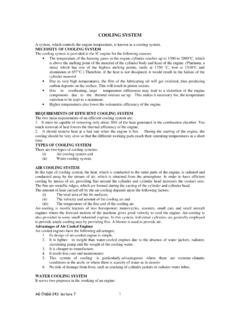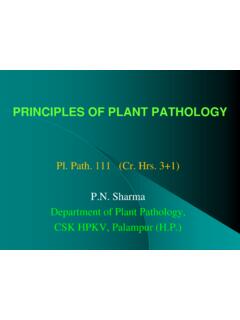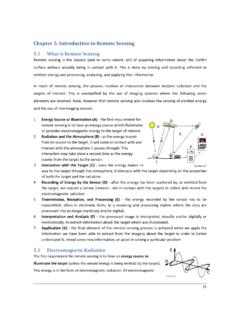Transcription of Lecture 6 Fuel System - hillagric.ac.in
1 fuel & fuel System . PROPERTIES OF fuel . fuel is a substance consumed by the engine to produce energy. The common fuels for internal combustion engines are: 1. Petrol 2. Power kerosene 3. High speed diesel oil 4. Light diesel oil. The important properties of these fuels are given below: Name of fuel oil A. P. I. Specific Calorific value degree Gravity kcal/kg (i) Light diesel oil ( ) 22 10300 18600. (ii) High speed diesel oil (HSD) 31 10550 19000. (iii) Power kerosene 40 10850 19500. (iv) Petrol 63 11100 20000. QUALITY OF fuel . The quality of the fuel mainly depends upon the following properties: 1. Volatility of the fuel 2. Calorific value of the fuel 3. Ignition quality of the fuel Volatility: Volatility of fuel has considerable effect on the performance of the engine by affecting the following: (i) Ease of starting the engine.
2 (ii) Degree of crankcase oil dilution, (iii) Formation of vapour lock in the fuel System , (iv) Accelerating characteristics of the engine, (v) Distribution of fuel in multi-cylinder engine. In I. C. engine, all the liquid fuel must be converted into vapour fuel before burning. High speed diesel oil is most difficult to vapourise. Vapourising temperature of high speed diesel oil is higher than that of the petrol, hence the petrol vapourises quicker than diesel oil in the engine cylinder. This helps in easy starting of petrol engines. Calorific value: The heat liberated by combustion of a fuel is known as calorific value or heat value of the fuel . It is expressed in kcal /kg of the fuel . The heat value of a fuel is an important measure of its worth, since this is the heat which enables the engine to do the work.
3 Ignition quality: Ignition quality refers to ease of burning the oil in the combustion chamber. Octane number and cetane number are the measures of ignition quality of the fuel . (a) Octane number: It is a measure of knock characteristics of a fuel . The percentage of iso-octane (C8 H18). in the reference fuel consisting of a mixture of iso-octane and normal heptane (C7H16), when it produces the same knocking effect as the fuel under test, is called octane number of the fuel . Iso-octane has excellent antiknock qualities and is given a rating of 100. Normal heptane would knock excessively and hence it is assigned a value of zero. (b) Cetane number: The percentage of cetane in a mixture of cetane (C16 H34) and alphamethyl naphthelene (C11 H16) that produces the same knocking effect as the fuel under test is called cetane number of the fuel .
4 Diesel fuels are rated according to cetane number which is the indication of ignition quality of the fuel . The higher the cetane number the better the ignition quality of the diesel fuel . The commercial diesel fuels have got cetane rating varying from 30 to 60. Detonation (Knocking): Detonation or engine knocking refers to violent noises, heard in an engine, giving a pinging sound during the process of combustion. It occurs during the process of combustion of the AG ENGG 243 Lecture 6 1. mixture within the cylinder after the ignition has taken place. It is an undesirable combustion and results in sudden rise in pressure, a loss of power and overheating of the engine. It is caused by improper combustion chamber, high compression pressure, early ignition timing, improper fuel and inadequate cooling arrangement.
5 Pre-ignition: Burning of air- fuel mixture in the combustion chamber before the piston has reached the top dead centre is called pre-ignition. Pre-ignition occurs when the charge is fired too far ahead of the top dead centre of the piston due to excessive spark advance or excessive heat in the cylinder. fuel SUPPLY System IN SPARK IGNITION ENGINE. The fuel supply System of spark ignition engine consists of: (i) fuel tank (ii) fuel filter (iii) Sediment bowl (iv) fuel lift pump (v) Carburettor (vi) fuel pipes (vii) Inlet manifold In some spark ignition engine, the fuel tank is placed above the level of the carburettor. The fuel flows from the fuel tank to the carburettor under the action of gravity. There are one or two filters between the fuel tank and the carburettor.
6 A transparent sediment bowl is also provided to hold the dust and dirt of the fuel . If the tank is below the level of the carburettor, a lift pump is provided in between the tank and the carburettor for forcing fuel from the tank to the carburettor of the engine. The fuel comes from the fuel tank to the sediment bowl and then to the lift pump. From there the fuel goes to the carburettor through suitable pipe. From the carburettor, the fuel goes to the engine cylinder, through the inlet manifold of the engine. fuel System of spark ignition engine. CARBURETTOR: The process of preparing an air- fuel mixture away from the cylinders of an engine is called carburetion and the device in which this process take place is called carburettor. Principle of carburettor: The basic principle of all carburettor design that when air flows over the end of a narrow tube or jet containing liquid, some liquid is drawn into the air stream.
7 The quantity of liquid drawn into the air stream increases as the speed of air flow over the jet increases and also the quantity is greater if the jet is made larger. AG ENGG 243 Lecture 6 2. Carburettor with pump feed to fuel reservoir Diaphragm type fuel pump In practice, the fuel level in the jet is maintained by a float chamber. The fuel levels in the jet and in the float chamber are always the same. As the fuel is consumed, the level in the float chamber goes down. The float in the float chamber also goes down and the needle valve comes off its seat allowing more fuel into the chamber from the fuel tank. When the fuel level rises to its correct level, the float presses the needle valve back to its seat and cuts off the fuel flow. The velocity of the air flowing over the jet is increased by a constriction in the induction pipe known as venturi.
8 A throttle butterfly valve provides an adjustable obstruction in the induction pipe. It is used to control the flow of air- fuel mixture to the engine. As the butterfly valve is turned into the accelerate position, the airflow over the jet increases and more fuel is drawn out into the air stream, keeping the mixture strength constant. A second butterfly valve called choke is used to provide a richer mixture for the engine to start in cold condition. The choke controls the volume of air entering into the venturi. A second jet is fitted near the throttle butterfly, which is used when the engine is idling. fuel is delivered to the float chamber through fuel pipe either by gravity or by a pump. The float chamber is connected with the mixing chamber (venturi) via fuel nozzle equipped with fuel jet.
9 Function of Carburettor: The main functions of the carburettor are: (i) To mix the air and fuel thoroughly (ii) To atomise the fuel (iii) To regulate the air- fuel ratio at different speeds and loads and (iv) To supply correct amount of mixture at different speeds and loads. fuel System OF DIESEL ENGINE. During engine operation, the fuel is supplied by gravity from fuel tank to the primary filter where coarse impurities are removed. From the primary filter, the fuel is drawn by fuel transfer pump and is delivered to fuel injection pump through second fuel filter. The fuel injection pump supplies fuel under high pressure to the injectors through high pressure pipes. The injectors atomise the fuel and inject it into the combustion chamber of the engine. The fuel injection pump is fed with fuel in abundance.
10 The excess fuel is by-passed to the intake side of the fuel transfer pump through a relief valve. The main components of the fuel System in diesel engine are: (1) fuel filter (2) fuel lift pump (3) fuel injection pump (4) atomisers and (5) high pressure pipe. Cylinder Injector . Diesel Tank fuel Filter . fuel lift Filter fuel injection pump pump Flow diagram of fuel in diesel tractor AG ENGG 243 Lecture 6 3. Two conditions are essential for efficient operation of fuel System : (i) The fuel oil should be clean, free from water, suspended dirt, sand or other foreign matter, (ii) The fuel injection pump should create proper pressure, so that diesel fuel may be perfectly atomised by injectors and be injected in proper time and in proper quantity in the engine cylinder. fuel should be filtered before filling the tank also.








